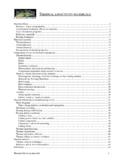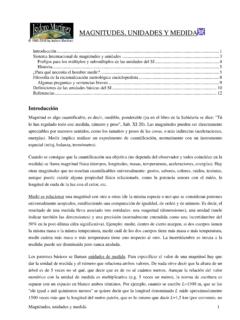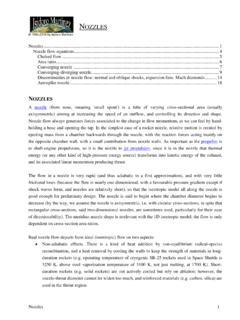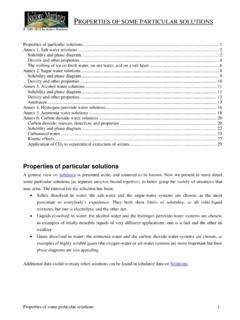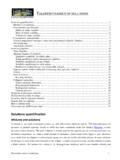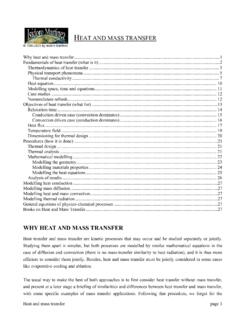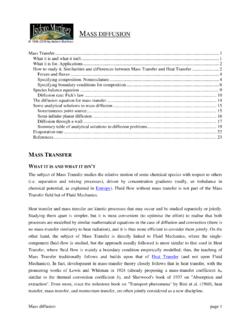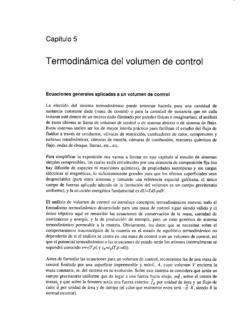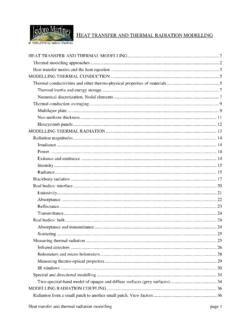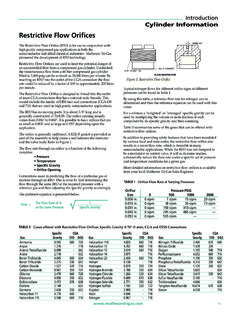Transcription of PROPERTIES OF GASES - UPM
1 PROPERTIES OF GASES (Function values at 100 kPa and 288 K or the normal boiling temperature if greater.) Substance Formula Molar mass M kg/mol Boiling temp. Tb K Critical temp Tcr K Critical pressure pcr MPa Critical compressibility factora Zcr Pitzer's acentric factor Thermal capacityb cp J/(kg K) Thermal conductivityc k W/(m K) Dynamic viscosityd 106 Pa s Acetone C3H6O 508 1300 Acetylene C2H2 309 1580 Air 79%N2+ 21%O2 82e 132g 1004 Ammonia NH3 406 2200 Argon Ar 151 0 523 Benzene C6H6 563 1300 1,3-Butadiene C4H6 425 1510 n-Butane C4H10 425 1580 iso-Butane C4H10 408 1580 Carbon dioxide CO2 304 840h 14.
2 4 Carbon monoxide CO 133 1100 Carbon tetrachloride CCl4 556 862 Cyclohexane C6H6 554 n-Decane C10H22 619 1680 n-Dodecane C12H26 659 1690 DME (dimethyl ether) C2H6O 400 1430 Ethane C2H6 305 1700 Ethanol C2H6O 516 1520 Ether (diethyl ether) C4H10O 467 1600 ETBE (ethyl tert-butyl ether) C6H14O 345 517 1550 Ethylene C2H4 283 1470 Ethylene glycol C2H6O2 471 645 1410 Helium (4He) He 5190 Helium 3 (3He) He n-Heptane C7H16 371 540 1650 n-Hexane C6H14 342 508 1700 Hydrazine N2H4 387 653 Hydrogen H2 33 14200 (Hydrogen) Deuterium D2 38 14200 12 Mercuryi Hg 630 736 104 Methane CH4 112 191 2180 Methanol CH4O 513 1350 MTBE (methyl tert-butyl ether)
3 C5H12O 328 497 1500 Neon Ne 44 0 1030 Nitrogen N2 126 1040 Nitrogen dioxidej NO2 431 800 130 Nitrogen monoxide NO 180 996 di-Nitrogen oxidek N2O 310 864 n-Octane C8H18 399 569 1700 iso-Octane C8H18 372 544 1650 Ozone O3 268 Oxygen O2 155 913 iso-Pentane C5H12 461 1680 n-Pentane C5H12 470 1680 Phenol C6H6O 455 694 Propane C3H8 370 1570 iso-Propanol C3H8O 508 1540 Propylene (propene) C3H6 365 1460 Propylene glycol C3H8O2 626 R12 (CFC-12) (dichlorodifluoromethane) CCl2F2 385 573 R134a (HFC-134a) (tetrafluoroethane) CF3CH2F 374 840 R410Al 345 820 Sulfur dioxide SO2 430 607 Sulfur hexafluoridem SF6 319 598 Toluene C7H8 592 Tetradecafluorohexane C6F14 329 449 Uranium hexafluoriden UF6 329f 503 370 20 Water (steam)
4 P H2O 2050p Xenon Xe 0 158 aCritical molar volumes can be obtained from vcr=ZcrRTcr/pcr, and critical densities from cr=M/vcr ( for acetone vcr=209 10-6 m3/mol and cr=351 kg/m3. bThermal capacities of monoatomic GASES do not change with temperature, but for polyatomic GASES it increases more the more atoms has the molecule. c Thermal conductivity of GASES increases with the square root of temperature, decreases with the square root of molar mass, and do not change with pressure. Thermal diffusivity a k/( cp). According to simple generalised transport theory in GASES , thermal diffusivity, mass diffusivity and kinematic viscosity of GASES have the same values.)
5 D Dynamic viscosity of GASES increases with the square root of temperature, and do not change with pressure. Kinematic viscosity / . e Bubble point. f Sublimation point. g Pseudo-critical point (Kay's model). h Most gas PROPERTIES vary a lot near the critical point, what may be here the case; , for CO2 gas at 288 K and 100 kPa, thermal capacity at constant pressure is cp=840 J/(kg K), growing at constant T=288 K from cp=833 J/(kg K) at very low pressure, to cp=3010 J/(kg K) at the saturation pressure (5063 kPa). Thermal capacity in the ideal gas limit (p 0) varies almost linearly ( cp=753 J/(kg K) at the triple-point temperature, cp=850 J/(kg K) at the critical-point temperature).
6 I Mercury is obtained by oxidation of cinnabar at some 600 C and vapour condensation. Mercury vapour should not exceed mg/m3 in breathing air (notice that saturated air at 20 C already contains more than that limit. j Nitrogen dioxide, NO2, is a very toxic brown gas at normal conditions (but readily condensable, Tb= C). All nitrogen oxides slowly decomposing to nitrogen and oxygen, making it difficult to keep them in pure state; besides, NO2 is paramagnetic, but readily dimerises to dinitrogen tetroxide, N2O4, a diamagnetic pale-yellow or colourless gas with double density than NO2 ( when heating from above an ampoule containing NO2, some N2O4 is formed at the top (2NO2(g)=N2O4(g)+57 kJ/mol), which can be seen sinking to the bottom because of buoyancy).)
7 The NO2/N2O4 equilibrium depends on temperature, NO2 being favoured at high temperatures and N2O4 at low temperatures; when condensing (at C at 100 kPa), most of the liquid is N2O4 which is colourless or pale brownish, and if solidified (at C) a white solid appears. The liquid N2O4 is a hypergolic propellant that spontaneously reacts upon contact with various forms of hydrazine, which makes the pair a popular bipropellant for spacecraft rockets. k Di-nitrogen oxide, N2O, also known as nitrous oxide (NO is nitric oxide), or nitrogen hemi-oxide, or nitrogen protoxide, or laughing gas, is used in respiratory anaesthesia since the pioneering trials of Sir Humphrey Davy in 1789 shortly after its discovery by J.
8 Prietsley in 1772, as a non-flammable non-ozone-depleting propellant in aerosol cans, and as a fuel additive to enhance combustion (it liberates oxygen; if added as compressed liquid in the intake manifold, it greatly increases fuel load). It has a global warming potential (GWP) of 300 times that of CO2, being the third contributor to anthropogenic GWP, after CO2 and CH4. l R410A is a near-azeotropic mixture of R32 (difluoromethane, CH2F2) and R125 (pentafluoroethane, CHF2CF3), 50/50 by weight (70/30 molar), which can be approximated as a pure substance. The critical point of a binary mixture is defined as the point where 2g/ x2 and 3g/ x3 are simultaneously zero, where g is the Gibbs energy and x is the mole fraction of a component.
9 M Sulfur hexafluoride is a synthetic gas used as insulator for electrical equipment (breakdown potential three times larger than air, and as a fluorine source for edging in the electronics industry. It is a non-flammable, non-toxic gas, which decomposes at 750 K; it has low water solubility, and a very large IR absortance (it is the most potent greenhouse gas, GWP=22 000), what has been used as a trace gas for gas-leakage detection. n Uranium hexafluoride, perhaps the heaviest simple molecule, is the only uranium compound presently used in industrially enrichment of U-235, both on gas diffusion and on gas centrifugation processes.)
10 At room conditions, it is a white crystalline solid with a high vapour pressure (pv=11 kPa at 20 C). p The boiling point of water at 100 kPa is Tb= K ( C), whereas at kPa (1 atm) it is K ( C). Steam thermal capacity varies appreciably with T and p: at p 0, cp(T) grows almost linearly from 1890 J/(kg K) at 100 C to 2130 J/(kg K) at 500 C, but a high-p it has a minimum ( at 200 kPa, cp=2180 J/(kg K) as saturated vapour at 120 C, drops to a minimum cp=2010 J/(kg K) at 230 C, and grows to match cp(T,p 0) at high-T, say cp=2130 J/(kg K) at 500 C). For the perfect gas model in adiabatic expansion of steam, a value of =cp/cv= is recommended.
